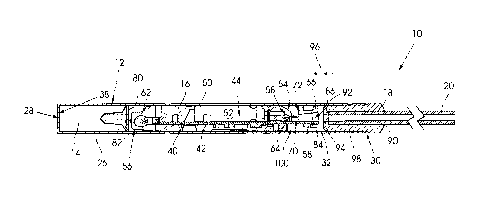Some of the information on this Web page has been provided by external sources. The Government of Canada is not responsible for the accuracy, reliability or currency of the information supplied by external sources. Users wishing to rely upon this information should consult directly with the source of the information. Content provided by external sources is not subject to official languages, privacy and accessibility requirements.
Any discrepancies in the text and image of the Claims and Abstract are due to differing posting times. Text of the Claims and Abstract are posted:
| (12) Patent: | (11) CA 3120759 |
|---|---|
| (54) English Title: | DETONATOR CONSTRUCTION |
| (54) French Title: | CONSTRUCTION DE DETONATEUR |
| Status: | Granted and Issued |
| (51) International Patent Classification (IPC): |
|
|---|---|
| (72) Inventors : |
|
| (73) Owners : |
|
| (71) Applicants : |
|
| (74) Agent: | OYEN WIGGS GREEN & MUTALA LLP |
| (74) Associate agent: | |
| (45) Issued: | 2023-07-11 |
| (86) PCT Filing Date: | 2020-01-24 |
| (87) Open to Public Inspection: | 2020-08-06 |
| Examination requested: | 2021-06-09 |
| Availability of licence: | N/A |
| Dedicated to the Public: | N/A |
| (25) Language of filing: | English |
| Patent Cooperation Treaty (PCT): | Yes |
|---|---|
| (86) PCT Filing Number: | PCT/ZA2020/050006 |
| (87) International Publication Number: | WO 2020160572 |
| (85) National Entry: | 2021-05-20 |
| (30) Application Priority Data: | ||||||
|---|---|---|---|---|---|---|
|
A detonator which includes a tube with an open end, a shock tube, secured to a plug which is fixed to an open end of the tube, an electronic module inside the tube, the module including a substrate which carries electronic components, and sensing structure mounted to the substrate spaced from an opposing end of the shock tube.
L'invention concerne un détonateur qui comprend un tube ayant une extrémité ouverte, un tube à choc, fixé à un bouchon qui est fixé à une extrémité ouverte du tube, un module électronique à l'intérieur du tube, le module comprenant un substrat qui porte des composants électroniques, et une structure de détection montée sur le substrat espacée par rapport à une extrémité opposée du tube à choc.
Note: Claims are shown in the official language in which they were submitted.
Note: Descriptions are shown in the official language in which they were submitted.

2024-08-01:As part of the Next Generation Patents (NGP) transition, the Canadian Patents Database (CPD) now contains a more detailed Event History, which replicates the Event Log of our new back-office solution.
Please note that "Inactive:" events refers to events no longer in use in our new back-office solution.
For a clearer understanding of the status of the application/patent presented on this page, the site Disclaimer , as well as the definitions for Patent , Event History , Maintenance Fee and Payment History should be consulted.
| Description | Date |
|---|---|
| Letter Sent | 2024-01-24 |
| Inactive: Grant downloaded | 2023-07-11 |
| Inactive: Grant downloaded | 2023-07-11 |
| Letter Sent | 2023-07-11 |
| Grant by Issuance | 2023-07-11 |
| Inactive: Cover page published | 2023-07-10 |
| Pre-grant | 2023-05-09 |
| Inactive: Final fee received | 2023-05-09 |
| Letter Sent | 2023-04-11 |
| Notice of Allowance is Issued | 2023-04-11 |
| Inactive: QS passed | 2023-02-20 |
| Inactive: Approved for allowance (AFA) | 2023-02-20 |
| Inactive: Request Received Change of Agent File No. | 2023-01-19 |
| Amendment Received - Voluntary Amendment | 2022-12-13 |
| Amendment Received - Response to Examiner's Requisition | 2022-12-13 |
| Examiner's Report | 2022-09-15 |
| Inactive: Report - No QC | 2022-08-23 |
| Common Representative Appointed | 2021-11-13 |
| Inactive: Cover page published | 2021-07-16 |
| Letter Sent | 2021-06-21 |
| Letter sent | 2021-06-16 |
| Priority Claim Requirements Determined Compliant | 2021-06-09 |
| Request for Priority Received | 2021-06-09 |
| Inactive: IPC assigned | 2021-06-09 |
| Application Received - PCT | 2021-06-09 |
| Inactive: First IPC assigned | 2021-06-09 |
| Request for Examination Requirements Determined Compliant | 2021-06-09 |
| All Requirements for Examination Determined Compliant | 2021-06-09 |
| Request for Examination Received | 2021-06-09 |
| Amendment Received - Voluntary Amendment | 2021-05-21 |
| Inactive: IPRP received | 2021-05-21 |
| National Entry Requirements Determined Compliant | 2021-05-20 |
| Application Published (Open to Public Inspection) | 2020-08-06 |
There is no abandonment history.
The last payment was received on 2023-01-12
Note : If the full payment has not been received on or before the date indicated, a further fee may be required which may be one of the following
Please refer to the CIPO Patent Fees web page to see all current fee amounts.
| Fee Type | Anniversary Year | Due Date | Paid Date |
|---|---|---|---|
| Basic national fee - standard | 2021-05-20 | 2021-05-20 | |
| Request for examination - standard | 2024-01-24 | 2021-06-09 | |
| MF (application, 2nd anniv.) - standard | 02 | 2022-01-24 | 2022-01-17 |
| MF (application, 3rd anniv.) - standard | 03 | 2023-01-24 | 2023-01-12 |
| Final fee - standard | 2023-05-09 |
Note: Records showing the ownership history in alphabetical order.
| Current Owners on Record |
|---|
| DETNET SOUTH AFRICA (PTY) LTD |
| Past Owners on Record |
|---|
| ANDRE LOUIS KOEKEMOER |
| CHRISTOPHER MALCOLM BIRKIN |
| MARK IVAN JURRAS III |
| MICHIEL JACOBUS KRUGER |
| RICHARD JOSEPH MICHNA |